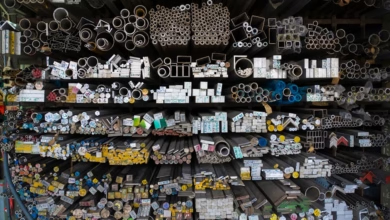Metals in Motion: Exploring Market Dynamics and Investment Strategies in Today’s Economy

In an era where economic dynamics are increasingly intertwined with technological advancements and environmental considerations, the role of metals in both industrial applications and investment strategies has never been more critical. This article explores the multifaceted nature of metal markets, beginning with silver, a metal that serves dual purposes as a critical industrial component and a sought-after investment asset. We will delve into how copper prices serve as a barometer for global economic health, while the surge in demand for rare earth metals underscores the shift towards green energy technologies. Additionally, we will compare platinum and palladium as investment options, assess how inflation influences the pricing of precious and industrial metals, and examine aluminum's future in a sustainable economy. Finally, we will discuss the implications of mining regulations on metal prices. By navigating these interconnected themes, we aim to provide a comprehensive overview of the metal markets and their significance in today’s economy.
- 1. "Navigating Metal Markets: The Dual Role of Silver in Industry and Investment"
- 2. "Copper's Economic Pulse: How Prices Signal Global Health"
- 3. "The Green Revolution: Rare Earth Metals and the Rise of Sustainable Technologies"
1. "Navigating Metal Markets: The Dual Role of Silver in Industry and Investment"
Silver occupies a unique position in the global markets, acting as both an industrial metal and a popular investment asset. This dual role significantly influences its pricing dynamics and overall demand.
In the industrial sector, silver is prized for its excellent conductivity, reflectivity, and antimicrobial properties, making it essential in various applications, including electronics, solar panels, medical devices, and batteries. As industries increasingly prioritize efficiency and sustainability, the demand for silver in technological innovations—particularly in renewable energy—continues to rise. For instance, the growth of solar energy systems has led to a surge in silver usage, as it is a critical component in photovoltaic cells. This industrial demand contributes to price fluctuations, especially in periods of heightened technological advancement or economic growth.
On the investment side, silver is viewed as a safe haven asset, akin to gold. Investors often flock to silver during times of economic uncertainty or inflationary pressures, as it is considered a hedge against currency devaluation. The accessibility of silver, both in physical form (such as coins and bars) and as financial instruments (like ETFs and futures), makes it an attractive option for a diverse range of investors. Market sentiment, geopolitical tensions, and macroeconomic trends can drive demand in the investment sector, further complicating price movements.
The interplay between these two roles—industrial and investment—creates a complex landscape for silver pricing. While industrial demand can stabilize prices during economic booms, investment demand may surge in times of crisis, leading to potential volatility. Understanding this duality is crucial for investors looking to navigate the silver market effectively, as shifts in one sector can significantly impact the other. As industries evolve and economic conditions change, silver's role as both a critical industrial material and a valuable investment asset will continue to shape its market dynamics.
2. "Copper's Economic Pulse: How Prices Signal Global Health"
Copper, often referred to as "Dr. Copper," serves as a barometer for global economic health due to its widespread use in various industries, including construction, electronics, and transportation. Its price movements are closely watched by economists and investors alike, as they tend to correlate with economic activity. When copper prices rise, it typically indicates increased demand driven by industrial expansion and infrastructure development. Conversely, falling copper prices may signal economic slowdowns or reduced manufacturing output.
The sensitivity of copper prices to global economic trends is largely due to its essential role in the production of goods and infrastructure. For example, a surge in construction projects or manufacturing activities in emerging markets can lead to higher copper demand, driving prices upward. Additionally, fluctuations in copper prices can reflect broader trends in the commodity market, influenced by factors such as supply chain disruptions, geopolitical tensions, and changes in trade policies.
Furthermore, copper's price dynamics are influenced by speculative trading and investor sentiment, which can amplify its role as an economic indicator. When investors anticipate economic growth, they may buy copper in anticipation of higher demand, pushing prices up. Alternatively, fears of recession can lead to sell-offs, resulting in price declines.
In summary, copper prices serve as a vital economic pulse, reflecting not only current industrial activity but also future growth prospects. Monitoring these price movements offers valuable insights into the overall health of the global economy, making copper a key metric for investors and policymakers alike.
3. "The Green Revolution: Rare Earth Metals and the Rise of Sustainable Technologies"
The increasing emphasis on sustainable technologies has catalyzed a surge in demand for rare earth metals, which are essential components in various green energy applications. These metals, including neodymium, dysprosium, and lithium, are critical for the production of high-performance magnets, batteries, and catalysts used in electric vehicles (EVs), wind turbines, and solar panels. As governments and industries worldwide commit to reducing carbon emissions and transitioning to renewable energy sources, the reliance on these rare earth metals has intensified.
The electrification of transportation is one of the most significant drivers of this demand. EV production relies heavily on lithium-ion batteries, which utilize lithium, cobalt, and nickel—elements classified as rare or scarce. Furthermore, powerful magnets made from neodymium are crucial for the efficiency of electric motors. As the automotive sector pivots towards electric mobility, the requirement for these metals is expected to rise sharply.
In addition to transportation, rare earth metals play a vital role in the development of renewable energy technologies. Wind turbines, for instance, depend on rare earth elements for the powerful magnets that enhance their efficiency. As countries ramp up investments in wind energy to meet climate goals, the demand for these metals will likely continue to grow.
However, this surge in demand comes with challenges. Mining and processing rare earth metals can be environmentally damaging, leading to concerns about sustainability and ethical sourcing. The geopolitical landscape also affects supply chains, as production is concentrated in a few countries, primarily China. This has prompted many nations to seek alternatives and invest in recycling technologies to reclaim rare earth metals from used products.
Overall, the Green Revolution is reshaping the landscape for rare earth metals, highlighting their essential role in advancing sustainable technologies while also presenting challenges that must be addressed to ensure a balanced approach to environmental stewardship and resource management.
In conclusion, the multifaceted landscape of metal markets underscores the crucial interplay between industrial demand and investment opportunities. Silver, with its dual role, highlights the growing intersection of technological innovation and financial strategy, while copper’s price fluctuations serve as a vital barometer for global economic conditions. The rising emphasis on green energy technologies not only drives demand for rare earth metals but also prompts a reevaluation of resource allocation in investment portfolios.
As investors weigh the merits of platinum versus palladium, it becomes clear that the dynamics of precious metals are heavily influenced by broader economic forces, including inflation and regulatory frameworks. Furthermore, the future of aluminum in a sustainable economy points to a pivotal shift towards materials that support environmental goals.
Ultimately, understanding the nuances of these metals and their market behaviors is essential for informed decision-making. By recognizing the impact of mining regulations and the shifting demands of a green economy, investors can better navigate this complex landscape, leveraging metals as a strategic component of diversified portfolios. As we look ahead, the interplay between innovation, regulation, and market sentiment will continue to shape the role of metals in both industry and investment, making it an exciting arena for stakeholders across the board.





